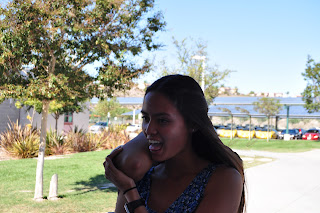Friday, October 26, 2012
Thursday, October 25, 2012
Wednesday, October 24, 2012
PDNEDU Notes
From the article "One to Watch: Louie Palu"
- Louie Palu, although nearly homeless and in poverty, provides the world with an insight during the war in Afghanistan, capturing moments that civilians would never see or speak of
- He say that he captures “the things that are the most difficult for us to talk about. The things that we really don’t want to look at or even think about. Things that are all about darkness”
- His inspirations are Robert Frank and Mary Ellen Mark, praising their courage in experiencing topics that can be so raw and controversial but also, would give great insight in things that other people wouldn't dare to live in
- After his intership with Mark that changed his life substantially, he began taking odd jobs since he couldn't quite find a photography job
- His father demeaned him since he didn't have a job, but then mentioned a Oregon mining job but instead of taking the job, he would make a job out of it by documenting their work
- This was Palu’s first big project, a 12-year extended series photographing gold miners’ daily lives, which eventually became the book Cage Call
- The mine was in Kirkland Lake, which Palu describes as “absolutely the middle of nowhere, about seven hours straight north of Toronto. The temperature was minus-15 Celsius. It was miserable.”
- “I didn’t care about anything except the fact that I was finally a documentary photographer working on what I felt was an important topic,” he explains. This was my subject and my story. I didn’t even think about getting anything published. I was just making pictures that were important to me.”
- He financed the project by returning to Toronto every few weeks to work construction and in bars
- He often slept in his car to save the cost of a motel room, until some of the miners eventually let him bunk on a sofa or in their guest room
- The resulting black-and-white photographs provide an unflinching portrait of the miners’ lives—the harshness of the land, the danger of the work and the damage life as a miner can inflict on the human body
- The tonal range of Palu’s images adds to their drama, with figures set against deep shadows or with the camera lens pointed directly into the bright spotlights that illuminate the mine shafts, rendering the figures and machinery as silhouettes
- The pictures also show the stark everyday lives of the miners and their families, with houses built in the shadow of a smelter’s huge smokestack, children playing in a school playground adjacent to a mine entrance, the faces of women who’ve lost fathers or husbands to mining accidents
- His portraits of men who’ve lost arms, suffered severe head injuries or been paralyzed in accidents reveal his subjects’ dignity and strength in the face of harsh adversity through capturing these moments in film
- It took several years before Palu felt he had a body of work he could begin showing, though the initial reception was less than enthusiastic. “Most people didn’t get it, and no one would hire me for an assignment. But I never let it deter me. I believed very strongly in what I was doing and knew that sooner or later, I’d find somebody who understood my work.”
- Very slowly, he began to appear on the radars of photo editors and art directors in and around Toronto, though he still wasn’t getting enough work to actually make a living.
- Then, in 2001, he was hired as a full-time staff photographer for the Toronto newspaper The Globe and Mail, where he had previously worked as a freelancer. The editors “wanted a photographer who wasn’t a photojournalist or standard news photographer and who could shoot differently for the paper,”
- One job he offered was to go to Kandahar and take pictures of the soldiers in battle, but he didn't have sufficient funds to travel from Afghanistan back to the US
- After his 5 year run, he then resulted in homelessness, without a home
- He later mentioned in one of his many lectures “I really like teaching, and somewhere down the road I can see teaching at a college somewhere, at least part-time,” he says. “And I know that someday, I’m really going to enjoy having furniture.”
MOPA Notes
- The Museum of Photographic Arts, founded in 1974, is one of three museum dedicated to the art of photography
- The collections include film and video, and is located in El Prado, San Diego
- Many artists exhibit their work in this museum since it is the optima place to have others see their work, thorough their emotions, work, and photos
- Photography proved it could capture permanent images more precisely than an artist’s hands.
- Early scientists discovered this image making process, others began to experiment with the abilities of the camera to capture a precise moment
- One of the earliest motion images showed pedestrians and horse-drawn carriages frozen in unusual postures the mechanics of the camera would further evolve to capture what the eye could not see
- Artists and scientists both strive to better understand the world around us
- After that, photography became a tool to feed a desire for facts and increased scientific understanding.
- Photography processes captured new forms of visual information and allowed for the world to be closely dissected
- Photographs of scientific specimens, which reveal surface structures of animal and nature forms, were able to significantly impact a number of photographers
- Distinguished by a neutral presentation and emphasis on discovering structure, these images share some of the characteristics associated with scientific inquiry
- These first images exemplify their respective process’ ability to create accurate reps of the subject
- Whether used as a document, or admired for their beauty, these images represent the inherent relationship of science and art working together to introduce a new visual medium
- Photography is the result of combining several different technologies invented over many years
- These technologies continue to evolve even to this very day
- As photographic equipment becomes more diverse, the ability to make variations of portraits gives photographers more freedom and creativity to capture what they truly feel
- It seems as if it is almost impossible to image a time before photography existed
- The invention of photography brought together optics, chemistry and technology, allowing people to see the world in a dramatically new way
- A photograph became a way of communicating information about other people, places, and cultures. Photography provided new and exciting ways to see what was once visually unknown to something appearing right before their very eyes
- The photograph allowed a new way of looking at ourselves
- With the invention of the camera, photography became an essential tool in recording human behavior, customs, and lifestyles
- A portrait is a story filled with clues and ideas about who a person is, what their status in society is, and sometimes even, a reflection of their self-worth
- MOPA can exhibit these behaviors captured in split moments, detailing what i s going on at an exact moment, enabling a time where future generations can look down on
Monday, October 22, 2012
Wednesday, October 17, 2012
Monday, October 15, 2012
Friday, October 12, 2012
Flash Photography Assignment
- Used in photography for artificial light
- Can be 1/1000 - 1/200 of a second long
- Used for iluuminating a dark scene, fast-moving objects, changing the quality
- The earliest flashes used flash powder (mix of magnesium powder and potassium chlorate), then it was the flash lamp invented by Joshua Cohen
- Flash lamp replaced by flash bulb, magneisum filaments were electronically ignited by contact witht eh camera shutter
- Other types of early flash technology are flash cube, magicubes, flashbar, flipflash
- Electronic flash using electronic circutry developed also
- Air-gap flash is an extremely fast flash (less than one microsecond) used more by scientists capturing fast moving objects like bullets tearing through light bulbs or batteries
- Multiple flashes can be used to find depth edges or create stylized images causing shadows in scenes
- Flash units can be expressed by t.5, which means the flash impluse is above .5 (50%) of peak intensity
- Flash LED illumination is used in camera phones becayse of their low voltage operation, higher efficiency, and extreme miniaturization
- Electronic flash units have compatibility issues with focal-plane shutters
- Fill flash describes the flash used to supplement ambient light in order to illuminate a subject close to the camera that would be in shade
- Bounce flash is directed onto a reflective suface, can look less articficial looking
- Slave flash is set up away from the subject and camera, triggered by the light from the main flash
- Correction gels are used to change the color of the flash
- Using on-camera flash will give a very harsh light, which results in a loss of shadows in the image using an umbrella or softbox (the flash will have to be off-camera for this) makes softer shadows
- A typical problem with cameras using built-in flash units is the low intensity of the flash; the level of light produced will often not suffice for good pictures at distances of over 3 meters or so.
- Dark, murky pictures with excessive image noise or "grain" will result. In order to get good flash pictures with simple camera an umbrella, and can even be used against sunlight, at short distance
- The "red-eye effect" is another problem with on camera and ring flash units. Since the retina of the human eye reflects red light straight back in the direction it came from, pictures taken from straight in front of a face often exhibit this effect.
- It can be somewhat reduced by using the "red eye reduction" found on many cameras (a pre-flash that makes the subject's irises contract)
- On some cameras the flash exposure measuring logic fires a pre-flash very quickly before the real flash. In some camera/people combinations this will lead to shut eyes in every picture taken
- Flash distracts people, limiting the number of pictures that can be taken without irritating them
- Photographing with flash may not be permitted in some museums since only assholes do that
- Flash equipment may take some time to set up may need to be carefully secured, especially if hanging overhead so it does not fall on anyone
Wednesday, October 10, 2012
PPIV: Recreation of Art (with Denise Delosreyes) Period 6
Mona Lisa
Leonardo da Vinci
Cherubini
Raphael
Girl With The Pearl Earring
Johannes Vermeer

Whistler's Mother
James McNeill Whistler
Portrait of a Young Woman
Sandro Botticelli
Mlle Irene Cahen d'Anvers
Renoir
Ophelia 1889
Sir John Everett Millais
Study of Hands
Leonardo da Vinci
Little Dancer of Fourteen Years
Edgar Degas
Peach Trees in Blossom
Vincent Van Gogh
Subscribe to:
Comments (Atom)













.jpg)
.jpg)
.jpg)








































